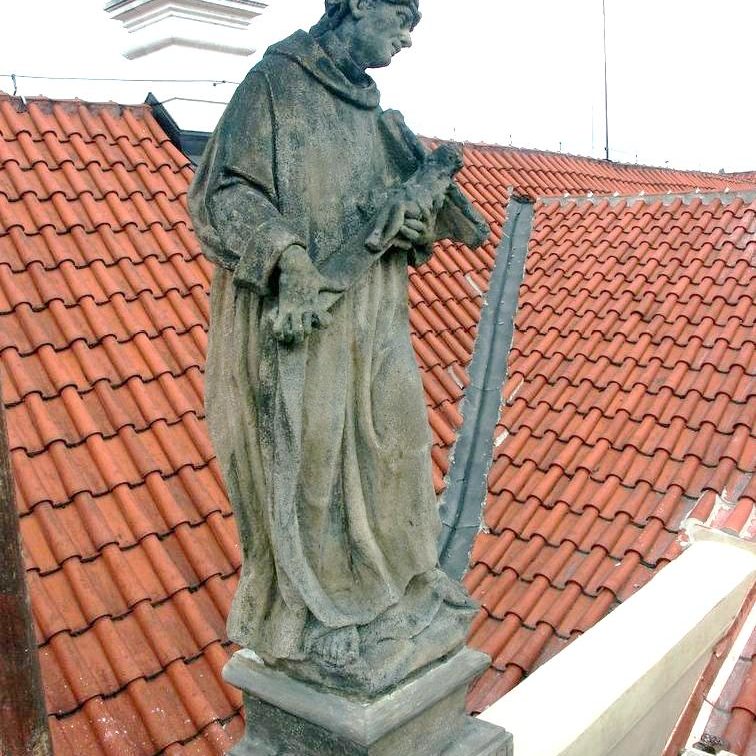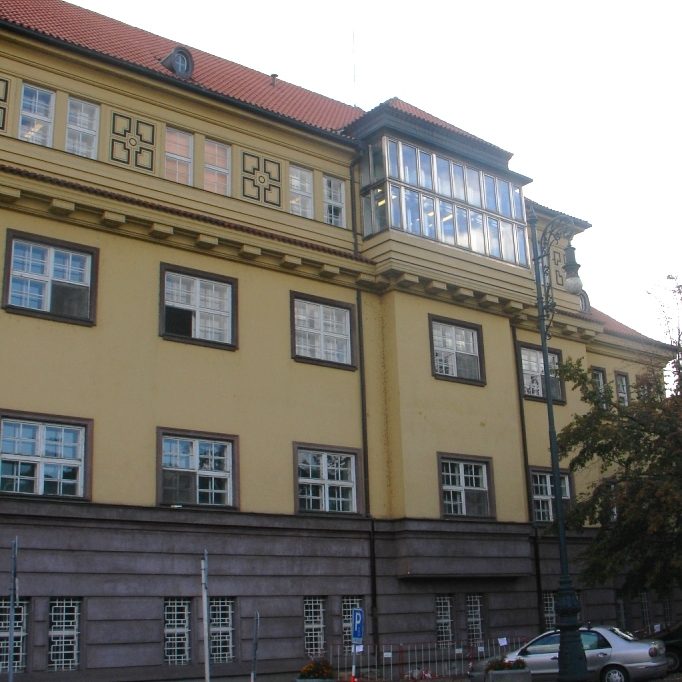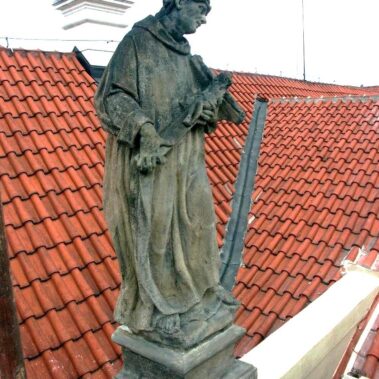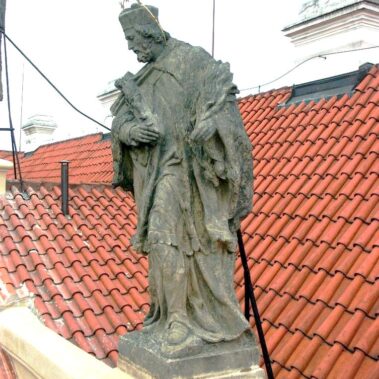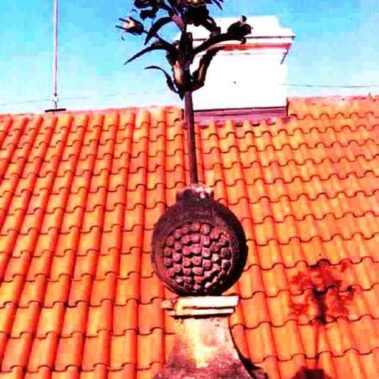Hospital “Na Františku” – restoration of sculptural decorations, Czech Republic

| Address: | Nemocnice Na Františku, Na Františku 847/8, 110 00 Praha |
|---|---|
| Description of work: | Restoration survey
Restoration of figurative sculptures on the south and east façade Restoration of stone vases and decorative motifs with metal floral ornaments |
| Contractor: | GEMA ART GROUP a.s. |
| Investor: | City District of Praha 1 |
| Implementation: | 05/2006 – 07/2007 |
The history of the Hospital Na Františku goes back to 1354, when the original hospital was founded by rich Prague burgher Bohuslav of Olbramovice. The establishment was then known as “Bohuslav’s spittal”. It was built in close proximity to the chapel of St Simon and St Jude, erected here in 1344. Within the spittal was an apothecary, where curative potions were brewed. The hospital also fulfilled a social function, as food was given to the poor in front of it.
The aftermath of the Battle of White Mountain in 1620 brought about change. The spittal and its surrounding land became the property of the Catholic Hospitaller Order, supporters of the Catholic Emperor Ferdinand II. The order was founded in 1537 in Spain by St John of God and its main mission was selfless care for the sick.
Fresh building work commenced in 1621, when a new Early Baroque Church of St Simon and St Jude, officially opened in 1632, was erected. Space in the original chapel was converted for hospital use. It was also necessary to build a new convent for the members of the order. Further building expansion took place after the end of the Thirty Years’ War in 1648. The architect Jan de Caupalli was the author of the project and the artist Tomaso Soldatti participated in the work on the sculptural ornamentation. The conversion of the complex was strongly supported by the Czech high nobility.
The most extensive building alterations were carried out in the first half of the 18th century under the leadership of the architect Jan Josef Hrdlička. The High Baroque appearance of the complex, acquired between the years 1751 and 1753, is largely preserved to this day. The sculptures on the attic ledge of the Hospital Na Františku originate from this era. It is presumed that their author was the sculptor Jan Jiří Šlanzovský.
Another major reconstruction took place between 1923 and 1927, when a modern extension, designed by architects Vilém Kvasnička and Jan Mayer, was added to the original spittal. The sgraffiti were the work of František Rubeš and the sculptural decorations were created by Čeněk Vosmík.
During World War II the hospital was closed and its premises served as accommodation for the German army and later as a Luftwaffe military hospital. Extensive efforts to restore the original function of the hospital were made as early as 1945. The complex of the Hospital Na Františku belongs amongst the oldest hospitals or “spittals” of the Czech lands; it also has a significant place in the country’s history of medicine due to its role in the practical education of medical students.
The aim of the restoration work was to salvage four Baroque statues of saints dating back to the years 1751 – 1753, two copies of figurative sculptures from 1916, six decorative pomegranates and two stone vases. The sculptures were created using six different kinds of stone and were placed on brick or stone plinths on the south and east sides of the former monastery, now the Hospital Na Františku .
During their long history, the sculptures were repeatedly reconstructed, not always with a beneficial outcome. Damaged segments of the stone were during repairs covered by cement grouts, underneath which the stone suffered even more intensive deterioration. Further problems were cause by gypsum crusts, which affected the stone especially in the areas of rain shadow. The critical state of the vases and decorative pomegranates was aggravated by advanced corrosion of the metal pins inside the sculptures. In some cases the sculptures had been damaged to such a degree that they had to be placed in a lapidarium after restoration, as exposure to the elements would have meant their destruction.
All restoration work carried out was based on the evaluation of the survey results and was guided by a desire to secure and rehabilitate what remained of these valuable monuments. All work was carried in accordance with Act No. 20/1987 Coll. on the State Care of Monuments.
Restoration survey:
Prior to the commencement of specialist restoration work on the six Baroque sculptures and other sculptural elements in May 2006 a detailed restoration survey had been carried out in 2005, which formed the basis for the restoration schedule and for selection of techniques used in the work. The sculptures were examined using ultrasound, which enabled the experts to establish the level of inner damage and possible lack of homogeneity in the material. A Karsten Tube test was used to determine the extent of water penetration in the stone. Samples for micro chemical analysis were taken to ascertain the composition of individual binding materials. Petrographic examination was carried out with the aim to establish the type and provenience of the stone of the sculptures.
Restoration of the figurative sculptures on the south and east facade:
Six statues of saints were subjected to restoration: those of St John of God, the Most Holy Saviour, St Francis Xaverius, St Wenceslas, St John of Nepomuk and the Archangel Gabriel. Four of these statues are originals dating to the years 1751 to 1753. The statues were made from several kinds of sandstone, mostly from the Žehrovice quarry. The statues of St John of Nepomuk and the Archangel Gabriel are copies from 1916 made by the sculptor Čeněk Vosmík. The statues were in a critical state. Unsuitable repairs using non-breathable cement material caused corrosion of the stone, growth of surface sulphate crusts and numerous fissures, and had to be removed. Most damaged was the statue of the Most Holy Saviour: part of the left hand, holding the attribute of the globe, drapes of the garment as well as part of the head have all had fallen off. The missing part of the head had been reconstructed using grey cement. The lower part of the statue exhibited an extensive crack. The statue was anchored by means of an iron bolt, which was heavily corroded. The statue of St Wenceslas was also seriously damaged and its surface exhibited intensive corrosion of the stone in the areas around the head and the neck. Parts of the arms had fallen off. For these reasons it was decided to replace the original with an exact copy.
Affected stone of the original statues of St Wenceslas and the Most Holy Saviour was consolidated using organosilicate and the corroded metal bolts replaced with new ones. The restored sculptures were placed in a lapidarium and copies were installed on the attic ledge of the building.
It was possible to salvage two of the original statues, that of St John of God and St Francis Xaverius. Their surfaces were first rid of dust deposits using steam and distilled water. Areas with gypsum crusts were cleaned by the method of micro-sanding, which thinned the crusts. Unsuitable repairs and additions were removed and in-depth selective consolidation with organosilicates and sealing of cracks were carried out. Where the fissures were extensive, they were in-filled using mineral based artificial stone. To conclude, the surfaces were colour retouched. Attributes of the saints, made of metal, were also renovated and gilded using gold leaf.
Copies of statues of St John of Nepomuk and the Archangel Gabriel from 1916 were well preserved. As part of the general restoration their surfaces were cleaned using a steam generator and distilled water. Chemical crusts were thinned by micro-sanding. Strengthening of the statues was also indicated due to the inherent weakness of Hořice sandstone.
Vases and pomegranates with metal floral ornaments:
Sculptural ornamentation of the attic ledge of the Hospital Na Františku included six stone ornaments with motifs of pomegranates and two stone vases.
The stone vases were in a dilapidated state and had to be replaced with copies. The main cause of the damage were the corroded metal pegs, which ripped the sculptures apart from within. These metal parts were very carefully removed from the vases and the surfaces were subsequently cleaned of dust and crusts. Following in-depth consolidation cracks were sealed and broken pieces glued back. Missing parts were reconstructed using artificial stone. The originals were placed in a lapidarium and copies of the vases were placed on the ledge.
The stone pomegranates decorated with metal floral ornaments were also found to be in poor shape. The reasons were the same as in the case of the stone vases: the volume of the metal pegs inside the pomegranates had increased due to corrosion, disturbing the stone and causing extensive open cracks on their surface. The necks of the pedestals were also broken. The pegs from the pomegranate shapes were removed, the cracks repaired and reinforced with anticorrosive round pegs. The broken necks were glued and finally any minor damage was retouched.
Metal parts of the pomegranates were cleaned and then rid of corrosion. Missing parts were replaced with replicas and all surfaces preventatively treated with an anti-corrosive agent. To conclude, gold leaf was applied.







